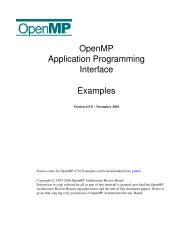D2 3 Computing e-Infrastructure cost calculations and business _models_vam1-final
D2 3 Computing e-Infrastructure cost calculations and business _models_vam1-final
D2 3 Computing e-Infrastructure cost calculations and business _models_vam1-final
Create successful ePaper yourself
Turn your PDF publications into a flip-book with our unique Google optimized e-Paper software.
e-‐FISCAL: www.efiscal.eu <br />
EC Contract Number: 283449 <br />
EXECUTIVE SUMMARY<br />
Over the last ten years the European countries <strong>and</strong> the EC have made significant investments in e-‐<strong>Infrastructure</strong>s <br />
for scientific computing, notably High Throughput <strong>Computing</strong> (HTC) <strong>and</strong> High Performance <strong>Computing</strong> (HPC) <br />
services. Their contributions have made it possible for the European research to maintain most prominent role in <br />
solving key global challenges. The approach has been validated by a growing number of research initiatives <strong>and</strong> <br />
success stories such as the recent discovery of the Higgs boson. Sustainability of such services is essential, as the <br />
research supported by them is also more <strong>and</strong> more crucial for European competitiveness – however, sustainability <br />
can only be planned if the <strong>cost</strong>s are known. The emerging commercial offerings (Cloud-‐based HTC <strong>and</strong> HPC <br />
solutions) pose additional opportunities <strong>and</strong> challenges for sustainability. It is thus important to underst<strong>and</strong> the <br />
<strong>cost</strong> of the dedicated computing related e-‐<strong>Infrastructure</strong>s, as primarily expressed by EGI <strong>and</strong> PRACE initiatives, <br />
both in their current state <strong>and</strong> in their evolution towards the Horizon 2020 framework. The calculation of such <br />
<strong>cost</strong>s is not trivial; keeping detailed accounting data for the evolving mix of capital (hardware) <strong>and</strong> operational <br />
(personnel, energy) expenditures is only one of the challenges. This is because, each of the compared <br />
infrastructures among the HPC, HTC <strong>and</strong> Cloud offerings have their distinct characteristics <strong>and</strong> use-‐case <br />
applications. For example, high-‐end HPC systems tailored for capability computing deploy state of the art <br />
hardware <strong>and</strong> network as compared to HTC infrastructure. <br />
The goal of the e-‐FISCAL project has therefore been to analyse the <strong>cost</strong>s of the current European dedicated HTC <br />
<strong>and</strong> HPC computing e-‐<strong>Infrastructure</strong>s for research <strong>and</strong> compare the service components provided with equivalent <br />
commercial leased or on-‐dem<strong>and</strong> offerings. With regard to the comparison, it is crucial to keep in mind that the <br />
service palette provided by the computing e-‐<strong>Infrastructure</strong>s – which includes advanced user support, engagement <br />
with user groups, cross-‐organisational authentication <strong>and</strong> authorisation mechanisms – extends beyond the basic <br />
Cloud computing service used in the comparison. Furthermore, the results should not be used to evaluate moving <br />
from in-‐house to commercial public clouds; this is a different exercise <strong>and</strong> is a next step requiring a different <br />
approach based on avoidable <strong>cost</strong>s, while this is also related to the qualitative value of e-‐<strong>Infrastructure</strong> that <br />
cannot be easily measured. Still, this <strong>cost</strong> comparison allows a baseline quantitative analysis of the <strong>cost</strong> ratios that <br />
is more easily repeatable than comparison addressing broader set of services <strong>and</strong> their qualitative aspects. <br />
To perform the <strong>cost</strong> analysis, the project developed a hybrid <strong>cost</strong>ing methodology that builds on the two main <br />
methodologies used for <strong>cost</strong> assessment in e-‐<strong>Infrastructure</strong>s: Total Cost of Ownership (TCO) <strong>and</strong> Full Cost <br />
Accounting (FCA) that have been used in most of the case studies identified in the state of the art analysis. <br />
However, neither of the methodologies was sufficient for reaching the e-‐FISCAL goals. While TCO is a useful <br />
concept in assessing the <strong>cost</strong> of a specific project over its useful life, it sets high dem<strong>and</strong>s for the analytical model <br />
<strong>and</strong> data used to make predictions. In a heterogeneous distributed e-‐<strong>Infrastructure</strong> it is very hard to come up with <br />
acceptably precise results by using a methodology that is almost completely forward-‐looking. On the other h<strong>and</strong>, <br />
FCA methodology relies on actual <strong>cost</strong> accounting data information that is dependent on the level of <strong>cost</strong> <br />
accounting systems sophistication by additionally inducing a backward looking stance, <strong>and</strong> gathering this type of <br />
information in Europe-‐wide infrastructure with sufficient accuracy <strong>and</strong> coverage is impossible. <br />
The e-‐FISCAL model is a hybrid model that approximates the <strong>cost</strong>s of maintaining services at their current level in <br />
the short to medium term. It does that without the need to identify funding sources or the exact time when the <br />
e-‐FISCAL : Financial Study for Sustainable <strong>Computing</strong> e-‐<strong>Infrastructure</strong>s <br />
Deliverable <strong>D2</strong>.3 – <strong>Computing</strong> e-‐<strong>Infrastructure</strong>s <strong>cost</strong> estimation <strong>and</strong> analysis – Pricing <strong>and</strong> <br />
Business <strong>models</strong> <br />
5




